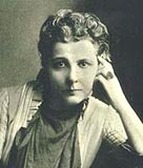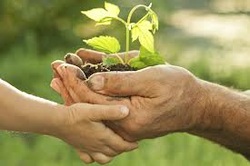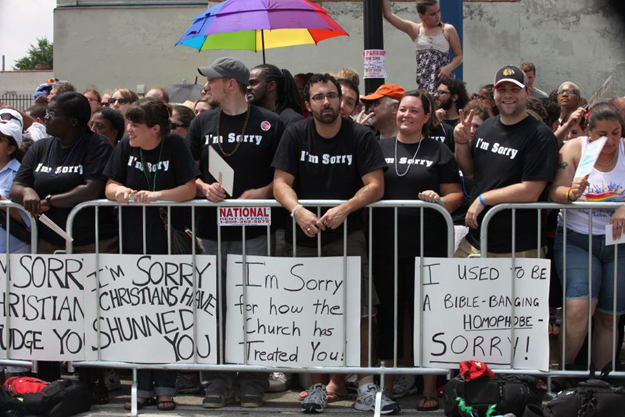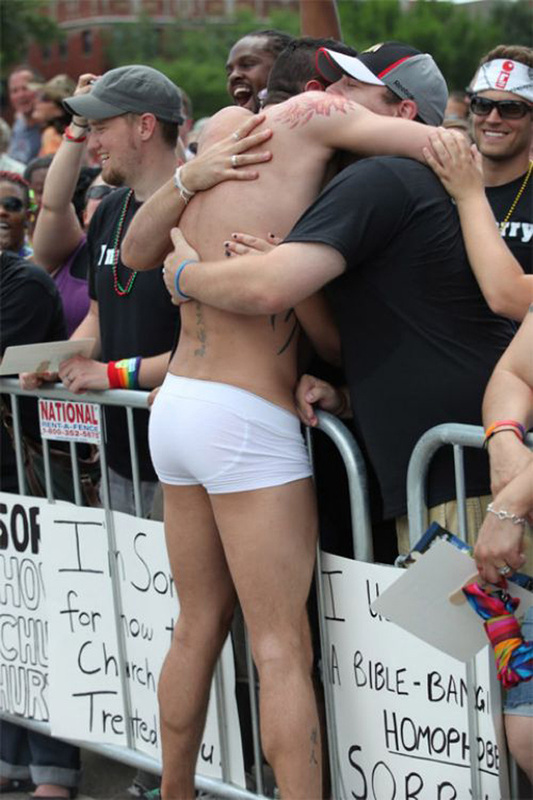Please watch the video above before reading.
This is an interesting way to look at the challenges faced by homosexual individuals in a heterosexual society. This video places you in a society where homosexuality is the norm, where "heteros" or "breeders" are shunned and mistreated just as homosexuals have been and are treated in our society. It flips traditional gender roles, posing the girls as playing football, the boys as acting. A "normal" relationship is one between two people of the same sex, the queer relationship between individuals of the opposite sex.
What I think this video really tells is that, beyond the science, the delineation, the criticisms in our society today, intolerance of homosexuality is mostly created by society. The video above presents it perfectly; there is no reason why we couldn't live this way, why this couldn't be where the world was and how people and relationships were perceived. Yet, its not, and most are going to find this really weird and disturbing because this is not what we have been trained to think normal. This is abomination from our perspective. But this kind of bullying and mistreatment really happens in society to those in the queer community of all ages and in different ways. If it is mostly society that breeds this hate, a society governed by us, then why can't we change things and stop this marginalization of other people?
Levi
One of the main arguments over human sexuality and equal rights for the LBGTQ community comes from the church. Not all religions believe in same-sex marriage, and many extremists openly express their beliefs of how it is “wrong.” This is hurtful for many, but everyone holds their own opinions. A group of Christians from Chicago realized how hurtful the Church can be towards LBGTQ and they went to a gay pride parade to apologize for homophobia in the Church.
The parade’s response was clearly forgiveness.
These two pictures restore some faith in humanity and give us hope for positive change.
Margeaux
 I have been studying sexual repression in the Victorian times to write a background on how sex was viewed during Darwin's career. In this research I have come across some truly inspiring historical figures that I may not have ever known about if I didn't have this project. Annie Besant has particularly inspired me, especially since this site has been highlighting a social issue of this time, which is how we view homosexuality. During Darwin's time there was not even rights for women, let alone people who were openly gay. Annie Besant took a stand to women's role in society as the caretaker of the family, in the 1870s she worked on the weekly National Reformer to advocate birth control, women's rights, and education. Thanks to Annie and others like her, I have the same rights to vote and work as a man. Her actions are what can inspire us today to sift through the facts of the media and science world and see that all people are equal, no matter what the eventual conclusion is to why humans are so diverse in their sexual behavior.
For more information visit: http://www.bbc.co.uk/history/historic_figures/besant_annie
Mary
Studying Darwin can get a little repetitive, especially because of his image as the father of evolution. Once you begin to get past the "Darwin wrote about evolution" part of research there is some very interesting information Darwin published that is lesser known to many. Darwin was particularly interested in birds and related many of their behaviors to sexual selection, and often to people's dismay linked bird behavior to human behavior. Darwin noted the natural plumage of male peacocks and the natural coy behavior of the female peacock and theorized that through this behavior, which is observable in the natural world, scientists would begin to understand how humans display the behaviors of sexual selection. Just for fun I looked up a few videos on other bird mating rituals to get a better understanding of how Darwin could study this subject so intensively, and I think with these videos it is easy to understand why.
Mary
There is a lot of hustle and bustle about legalizing gay marriage lately. Many celebrities take a stand on political issues and express their views to help popularize the issue and to aid in politicians’ campaigning. The artist, Macklemore, who recently performed in East Lansing, expresses his strong feelings about gay marriage through his music. In this popular music video, Macklemore raps about the typical stereotypes associated with homosexuality. He incorporates the hereditary aspect by thinking he is gay because “his uncle is,” and he emphasizes that since he can “keep his room straight” and “draw,” society tells him that he is gay. The touching lyrics mention that America fears the unknown and that “the right wing conservatives” think homosexuality can be cured with religion. It is a moving music video and a well-written rap that emphasizes that “Same Love” isn’t a choice with the lyric “I can’t change, even if I wanted to.”
Margeaux
On starting my research on Darwin and sexuality I was overwhelmed. Where do I start? Does Darwin even address sexual identity in his theory of evolution? These were all questions that vexed me and to be honest, hindered my initial research. I have now started to come to the realization that Darwin may not have explicitly written anything about gender identity or sexuality, but he started the conversation on sex. Darwin published during the Victorian era, a time when sex was considered necessary, but an evil only to be permitted in the institution of heterosexual marriage. People were not educated on the mechanisms of sex and saw sex and love as a mysterious, and (sometimes) divine part of humanity. Darwin changed this repressive culture of sex by uncovering the shroud of mystery behind sex, and pointing out its universal role in the natural world. Without Darwin, our understanding of sex and sexuality may have been a few years behind what it is today. It will be interesting to see how other scientists were inspired by Darwin’s naturalistic approach to sex.
Mary
_ Without deviation from the norm, progress is not possible.
-Frank Zappa
A word like progress has a general textbook definition, but what defines “the norm” varies wildly from person to person, much like the emotions a word like progress invokes. In a country still reeling from a real estate bubble collapse and recession, economic progress reads as a symbol of hope as people look ahead. Technological progress has defined how our generation communicates with each other. For many Americans, LGBTQ progress has nothing to do with civil rights progress, which evokes images of racial inequality and the rights finally granted to African Americans in the 1960s, nothing new. For them, the civil rights era has come and gone, an epoch to be fondly remembered, and the world in which they live today has become what they consider “the norm”. Of course, what was considered “the norm” fifty years ago was the exact reason for the start of the civil rights era in the first place. There came a time when a group of people realized that they disliked how the majority was defining “the norm”, and with hard work, dedication, and patience, they redefined it.
For the last few weeks, I have been combing both the Michigan State University and State News archives, looking for accounts that give perspective into how MSU’s community dealt with LGBTQ issues in the past to use as part of a timeline. The immediate thought I had was how amazing it was how far we’ve come. University studies from the early 1990s were met with a polarized reaction; news articles and eyewitness accounts from the 1980s and earlier portray a community aware of the presence of the LGBTQ community but intentionally deaf to its many voices; out of sight, out of mind dominated as the default attitude at MSU. One editorial response printed in the State News, published January 20, 1982, disparaged the State News for covering the dismissal of a fraternity brother based on his sexuality, and suggested they help put the gay rights movement “…back in the closet where it belongs.” My roommate, himself a member of MSU’s Greek community, assures me such attitudes are completely unwelcome in his fraternity today. Most people today would declare themselves progressive and would never harbor ugly or discriminatory feelings against another person. In spite of this, the future of LGBTQ progress hangs in the courts as the United States decides the fate of bills allowing or hindering gay marriage. Even the title of the Defense of Marriage Act explains the “norm” its proponents wish to preserve at the cost of progress, at the cost of basic civil rights.
The drawback of conveying progress with a timeline is that a timeline is constantly looking back when the nature of progress is always looking forward. It’s easy to look at the bad events of the past and contrast them to the present as evidence of progress and say, “Look how far we’ve come!” Doing this may add to our hindsight, but it diminishes the potential for change in the future. The timeline of LGBTQ progress has not ended, and for as far as we have come, there are still goals that need to be met and there is still a ways to go. The present’s status on the ongoing timeline is still undefined and yet unwritten; it is our responsibility to define what our present is and what our “norm” will be. Only then will we ever know where we are now.
Chris
On Wednesday, April 10th, I accompanied Sarah and Chris to the Conrad archives to help them with some research for their timeline. I couldn't be happier that I did. It was touching to go through stories of past Michigan State Spartans. Reading through experiences during the 60’s or the 90’s or even just ten years ago, when they were in the same spot that we as student are now, was insightful. It is amazing to see how much has changed and how much still has not.
Margeaux
 Something nearly omnipresent in the studies of sexuality and gender in all forms of life is the idea of nature vs. nurture. This dichotomy holds that there are two aspects of a person that could potentially affect who they become, their "nature" or their inherent biology, which we typically take today to mean their genes, and "nurture" or the environment in which they developed and lived. The traditional viewpoint is that there is zero overlap between these two concepts, all or nothing; every aspect of who you become is affected by either your biology or your environment. Along with this comes the notion that the environment can be controlled while your internal biology cannot, making this issue seem very relevant in society.
I thought it might be interesting to see what is out there on this dichotomy that stretches far beyond sexuality. Below are two different talks that address this issue. The first is an explanation by University of Illinois Professor Gene Robinson. Although this study is done in bees and leaves me with far too much of a sociobiology taste (he even refers to his studies as 'sociogenomics'), it does do a great job of addressing nature and nurture even if this is applicable to humans in a much different way. In bees, older individuals are foragers while younger individuals are nurses, staying in and tending the hive and offspring. Sometimes, however, a large number of older bees will perish and the colony needs new foragers. What occurs is that younger bees will prematurely adopt the forager position in the colony. What is important here is the ability of these bees to respond to the environment in adopting this new position - bees will only do this in response to a decline in foragers. The genome of the bees changes as they become older and adopt the forager role, a result of gene activity. What is interesting is that these younger bees that adopt a forager role possess a genome that looks similar to that of the older foragers - meaning they changed their biology - their genes - as well.
What does this mean? The bees appear to be able to change their genes in response to changes in their environment, which lies somewhere in between the nature vs. nurture dichotomy. In this case it appears the nature and nurture are just 'two horns of the same bull' as described in the video - both effect behavior by acting on the genome. Something to point out here is that the genome does not necessarily equal genes in this case - we now know that biology goes beyond this and the inherited genes can be differentially expressed by other genetic means.
The second video is quite a bit shorter and probably a bit more related to the topic of this website. Here Dr. Louann Brizendine describes how we get our gender identity - is it inborn or does it come from how we are raised? She describes our biology as giving us predispositions towards certain behaviors. However, how we are socialized when young has a huge effect on shaping and reshaping our brains - most often in very stereotypical 'masculine' and 'feminine' ways that we are taught by our parents and by society. Neither is the complete answer - both have a role.
Both videos seem to support what I believe about the nature vs. nurture dichotomy - it's bull. Rather, who we are and how we behave is affected by both our biology and our environment in varying ways. Nature and nurture is not a dichotomy, but a continuum, the effect each has varying depending on what you are looking at. As with any question in science, there is no clear cut answer, and this is no exception. Keep this in mind while going through the research on this site and and any information you see in society. Also, please take the time to watch both of these short and informative talks I described above, which are embedded below.
Levi
I was doing some research for the project and something that I found struck me as unusually interesting and disturbing. In “Homosexuality and Science: A Guide to the Debates” by Vernon A. Rosario, I read about radical “cures” for homosexuality. One of these drastic cures was lobotomy. I normally would not had found the information as enticing because I would not be as informed on the subject, but my roommate is currently doing a research paper on the risks and uncertainties of lobotomy, so I know some more background on the barbaric procedure. For those of you who aren’t as informed (as I was just a month ago), a lobotomy consists of cutting or scraping away most of the nerve connections in the prefrontal cortex and the anterior part of the frontal lobes of the brain. It is a gruesome procedure that commonly results in many mental impairments and sometimes death. To think that anything could be cured with a lobotomy is slightly disturbing and to think that homosexuality needs a cure is equally, if not more, disturbing. Thank goodness time has progressed past lobotomy and is progressing past “curing” homosexuality.
Margeaux
|




 RSS Feed
RSS Feed